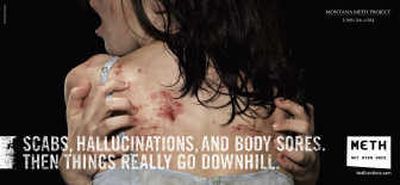Surge of anti-meth ads hints at what’s to come

Graphic anti-meth ads running on TV and in newspapers around the Inland Northwest are just a taste of what Idaho’s in for next year.
When the Idaho Meth Project kicks off – its goal is to start in January – the airwaves will be filled with images of blood, pale young people whose faces are riddled with sores, and in-your-face scenes of violence, car crashes, desperate teens and crime. All are designed to drive home one message, tailored for young people: Don’t use meth, not even once.
“It’ll saturate every media channel in this state,” said Megan Ronk, executive director of the Idaho Meth Project. “It’s going to hit every community. Essentially, when the campaign is launched, we’re going to be reaching 90 percent of that target population three to five times a week, so they’re going to be seeing the messaging everywhere they go.”
That includes on TV, in the pages of local and high school newspapers, on the radio and on billboards.
It’s all modeled after the Montana Meth Project, an effort in that state spurred by a private, nonprofit group. Started in 2005, the Montana campaign is credited by officials there with dramatically reducing meth use. Montana businessman Tom Siebel, the project’s founder, said in a video: “So many young people in Montana, their lives have been destroyed after first-time use. … This is a disaster.”
The project uses “research-validated, high-impact advertising that graphically communicates the risks of meth use,” according to its Web site.
Saturation ad campaigns modeled after the Montana Meth Project, and using the same ads, have kicked off in Illinois and Arizona. Hawaii and Idaho are next, with Gov. Butch Otter and first lady Lori Otter the top cheerleaders for Idaho’s effort.
Meanwhile, the White House Office of National Drug Control Policy liked the approach so much that it picked up two of the campaign’s TV ads and two of its print ads to run in Washington and seven other states with high levels of meth abuse. Those graphic ads are running along with ads from two other organizations, the Project for a Drug-Free America and a special project of the Tennessee attorney general’s office, which include messages focused on treatment.
“There’s somewhat of a myth out there that meth addiction is untreatable,” said Stephen Schatz, deputy press secretary for the federal drug control office. “One of our aims is to show that there is hope for those that are addicted to meth.”
The Meth Project campaign, by contrast, is focused solely on prevention and targets young people. “The whole theme of the campaign is ‘not even once’ and is targeted toward youth age 12 to 24 as a primary audience, and then the secondary audience is parents,” Ronk said. “Hopefully they can make a very educated decision through these ads that graphically communicate the risks of meth use.”
Ronk, whose Idaho Meth Project group is a private, nonprofit organization operating under the auspices of the United Way of Treasure Valley, acknowledged that there are other fronts on the fight against meth, from treatment for addicts to law enforcement. “But the only way we’re ever going to be able to really stop that flow of people using the drug, committing crimes, ending up in jail and needing treatment, is to ensure that people never start in the first place,” she said.
The White House office is running the ads in Washington, Alaska, California, Illinois, Indiana, Iowa, Kentucky and Oregon; they’ll continue for as long as six months, though not at the saturation level planned in Idaho.
The Meth Project’s TV ads use actors with fake sores and blood. But Ronk said, “This was a very professionally developed campaign. The experiences that they’re depicting are realistic – they don’t stretch the truth.”
Radio ads that are part of the project, by contrast, use young people featured in their home states who talk about their own experiences with the drug. Ronk said she’s lining up young Idahoans to tape the Idaho radio ads, in cooperation with school counselors, juvenile justice officials, and the Idaho Safe and Drug-Free Schools program through the state Department of Education.
She said, “We’ve got to take a proactive approach in making sure that young people understand that, sure, this drug may help you lose weight, it may give you more energy, but do you really know that you could lose your teeth and you could lose your hair and you could lose your life? So we need to tell them that other side of the story.”
The Idaho Meth Project hopes to raise $2.7 million before it launches, enough to operate for a year as one of the largest advertisers in the state. It has raised $1 million so far. Major donors include the Coeur d’Alene Tribe, the Idaho Hospital Association, Qwest Corp., Blue Cross of Idaho, Avista Corp. and Wal-Mart.
“The vision is to really keep this going for many years – frankly, I would say, until meth isn’t a problem in this state any more,” Ronk said.
The campaign will be hard to miss. Said Siebel, “Our television advertising is designed to break through the clutter and graphically communicate the risks of meth use.”